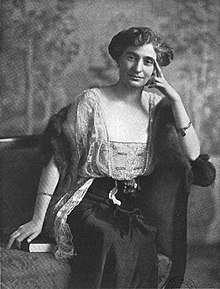Marie Van Vorst
Marie Louise Van Vorst (November 23, 1867 — December 16, 1936) was an American writer, researcher, volunteer during World War I, and painter.

Early life
Marie Louise Van Vorst was born in New York City, the daughter of Hooper Cumming Van Vorst and Josephine Adele Treat Van Vorst. Her father was a judge on the New York City Superior Court and president of the Century Club.[1]
Career
Van Vorst and her widowed sister-in-law, Bessie Van Vorst, moved to France and co-wrote novels together, including Bagsby's Daughter (1901). For The Woman Who Toils: Being the Experiences of Two Ladies as Factory Girls (1903), they went undercover at a pickle factory in Pittsburgh, ; a textile mill outside Buffalo, New York; a variety of sweat shops in Chicago; a shoe factory in Lynn, Massachusetts; and a Southern cotton mill to learn about working women's lives.[2] The book's introduction was written by Theodore Roosevelt.[3] Marie Van Vorst also wrote regularly for Harper's Magazine,[4] Good Housekeeping, and other national publications.[5]
Van Vorst's books include Philip Longstreth (1902), Amanda of the Mill (1905), Miss Desmond (1905), The Sins of George Warrener (1906), The Sentimental Adventures of Jimmy Bulstrode (1908), In Ambush (1909), First Love (1910), The Girl from His Town (1910), The Broken Bell (1912), His Love Story (1913), Big Tremaine (1914), Mary Moreland (1915), Fairfax and His Bride (1920), Tradition (1921), The Queen of Karmania (1922), Goodnight Ladies! (1931), and The Gardenia (1933).[6] Three of her novels were adapted for silent films before 1920.
During World War I, she volunteered as a field hospital worker at Neuilly and Paris,[5][7] and wrote War Letters of an American Woman (1916) about her experiences in the war zone.[8] In the same year she published a book of poetry, War Poems (1916). She returned to the United States to give lectures[9] and raise funds for American ambulances in France.[10] In 1918, she took charge of a postwar relief organization in Italy.[11] In 1922, Van Vorst was encouraged by artist Mary Foote to take up painting,[12] and exhibited her art in New York City.[1][13]
Personal life
Van Vorst married widower Count Gaetano Cagiati in 1916;[14] her small wedding ceremony was held at the Cathedral of Notre Dame in Paris. She adopted a son, a war orphan she named Frederick John Barth Van Vorst. She died from pneumonia in Florence, Italy, in 1936, aged 69 years.[15]
References
- Edd Applegate, Muckrakers: A Biographical Dictionary of Writers and Editors (Scarecrow Press 2008): 189-191. ISBN 9780810861084
- Katherine H. Adams, A Group of Their Own: College Writing Courses and American Women Writers 1880-1940 (SUNY Press 2001): 166-167. ISBN 9780791449356
- Marie Van Vorst and Mrs. John Van Vorst, The Woman Who Toils: Being the Experiences of Two Ladies as Factory Girls (Applewood Books 2010). ISBN 9781429040891
- Marie Van Vorst, Author Index, Harper's Magazine.
- Montrose J. Moses, "Novelist and Red Cross Nurse: A Study of Marie Van Vorst" Book News Monthly (November 1915): 102-104.
- Online Books by Marie Van Vorst, The Online Books Page.
- "Marie Van Vorst A French Nurse" Boston Daily Globe (March 24, 1915): 20. via Newspapers.com

- Marie Van Vorst, War Letters of an American Woman (John Lane Company 1916).
- "To Lecture Here on Italy" New York Times (February 12, 1918): 6.
- "Notes" The Dial (December 23, 1915): 624.
- "Novelist at Italian Front" New York Times (March 25, 1918): 6.
- "Woman Novelist Turned Painter at 53 Says Age Isn't A Handicap to Success" Freeport Journal-Standard (May 28, 1923): 11. via Newspapers.com

- "Marie Van Vorst Scored with her First Picture at 53" New York Times (May 27, 1923): X6.
- "American Authoress to Marry Italian; Miss Marie Van Vorst is Doing Red Cross Work" New Castle Herald (October 4, 1916): 1. via Newspapers.com

- "Marie Van Vorst, Author, 69, is Dead" New York Times (December 18, 1936): 25.
External links
| Wikimedia Commons has media related to Marie Van Vorst. |